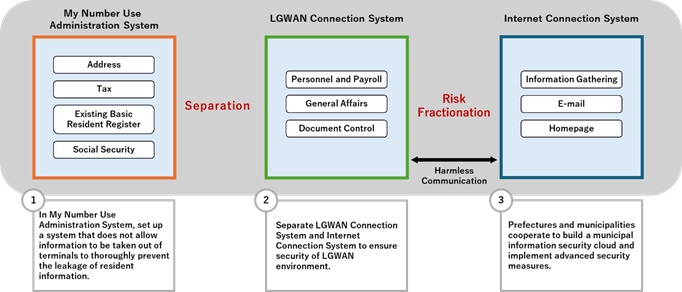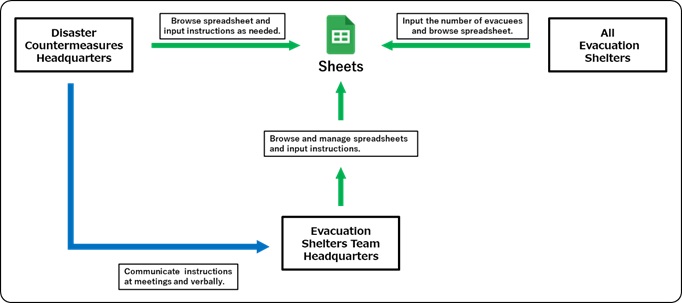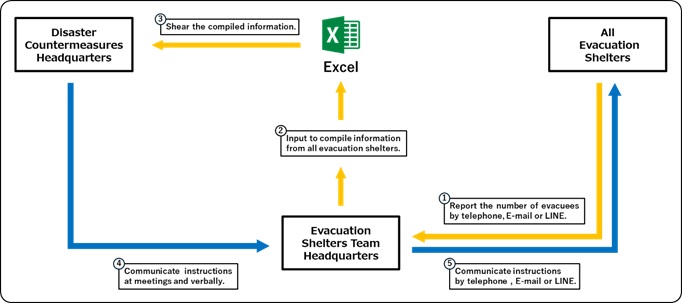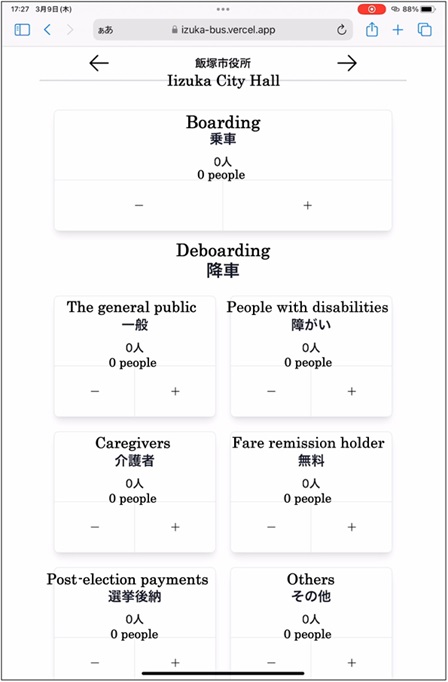Search for Articles
Technical Article Engineering in General Information Sciences Others
An attempt to realize digital transformation in local governments by utilizing the IT skills of information science students
Journal Of Digital Life.2025, 5,4;
Received:January 6, 2025 Revised:February 27, 2025 Accepted:March 18, 2025 Published:April 15, 2025
- Edmund Soji Otabe
- Department of Physics and Information Technology, Kyushu Institute of Technology
- Daigo Inatomi
- Department of Physics and Information Technology, Kyushu Institute of Technology
- Satoru Nakamura
- Division of Business Improvement and Digital Transformation, Iizuka City Hall
Correspondence: otabe@phys.kyutech.ac.jp
Abstract
Division of Business Improvement and Digital Transformation of Iizuka City Hall in Fukuoka Prefecture and students from Faculty of Computer Science and Systems Engineering at Kyushu Institute of Technology collaborated to attempt to use IT to improve various aspects of Iizuka City Hall's operations. First, Division of the Business Improvement and Digital Transformation solicited themes from divisions in Iizuka City Hall, selected around 10 from these and assigned university students to the themes to be solved. The information science students had a range of skill levels. They solved the problems in a variety of ways, including using automated processing, using cloud services, and developing software for tablet devices. While some of these methods have actually been used, there are also cases where they are not. This is thought to be because the system was created without sufficient consideration of how it would be used in the real case.
keywords:
1. Introduction
The Japanese government proposed regional revitalization in 2015 under the second Abe Cabinet. In 2015, which is considered the first year of regional revitalization, the Diet and local governments formulated a population vision and comprehensive strategy, and the first phase of projects was launched. In December 2020, a new guideline, the “Second Comprehensive Strategy for Overcoming Population Decline and Vitalizing Towns, People, and Jobs,” was announced. In June 2021, the basic policy, “Basic Policy for Overcoming Population Decline and Vitalizing Towns, People, and Jobs 2021,” was announced, and regional revitalization in Japan is currently in its second phase. Although a large amount of tax money, about 40 trillion yen, has been invested so far, and although the COVID-19 pandemic temporarily promoted migration to rural areas, the concentration of people in Tokyo and the influx of people into cities have not stopped. A difficult problem is that regional revitalization has the characteristic that even if there are some success stories, they cannot be expanded horizontally. In other words, it is very dependent on the region and the central figures who act independently. In 2021, the Kishida Cabinet proposed the “Digital Garden City Nation Concept,” emphasizing the importance of combining regional development with information technology. Furthermore, in 2024, the Ishiba Cabinet will set out policies to promote regional revitalization. In this way, regional revitalization has come to occupy a very important position for the country.
Although local national universities have been educational and research institutions, the Ministry of Education, Culture, Sports, Science and Technology has instructed them to include contribution to the local community in their mission (Ministry of Education, Culture, Sports, Science and Technology, 2012). Therefore, regional revitalization is important for local national universities. In fact, there are many examples of universities collaborating for the purpose of regional revitalization. (Fujio, Y. 2003) (Sakakibara, H. 2022) (Ministry of Education, Culture, Sports, Science and Technology, 2012) (Hagiwara, H. 2020) Many of these are examples of so-called liberal arts students going to the local area to solve problems. On the other hand, science students are busy with many experiments and exercises, so they have limited opportunities to go out and be active in the local area.
Iizuka City, Fukuoka Prefecture, where Faculty of Computer Science and Systems Engineering at Kyushu Institute of Technology is located, is a typical regional city with a population of 120,000, the fourth largest in Fukuoka Prefecture. Since it is possible to commute to the suburbs of Fukuoka City, which has a population of 1.3 million, in about 50 minutes, there are fewer economic development factors in Iizuka City. On the other hand, Iizuka City Hall has treated Kyushu Institute of Technology as a local university with great care and has engaged in various joint activities. In 2017, Kyushu Institute of Technology and Iizuka City entered a comprehensive partnership (Kyushu University, 2017). In April 2022, Department of Business Improvement and Digital Transformation was established at Iizuka City Hall. Students from Kyushu Institute of Technology entered the department and began supporting digital transformation. The Faculty of Computer Science and Systems Engineering at Kyushu Institute of Technology was established in 1986 as the first faculty of information engineering at a national university, and is still the only faculty of information engineering at a national university. Many graduates are active as engineers who support the information society. Therefore, students have a high interest in IT, and some of them have high skills. In particular, students these days can independently obtain and try the latest IT technology via the Internet, so they can create advanced services (Otabe, E.S. 2023). The deployment of IT technology in local government, which is the actual field, is also attractive to students.
In this study, we will introduce an initiative in which information science students from a local university cooperated with local government on digital transformation, and discuss the results and problems that were achieved. In particular, we considered the differences and benefits of working with specialists such as contractors and IT consultants.
2. Preparations
2.1 Collecting and assigning themes
First, the Division of Business Improvement and Digital Transformation notified each division in Iizuka City Hall that Kyushu Institute of Technology students would be helping with Digital Transformation (DX) and asked them to come up with themes they wanted to solve. From there, they selected around 10 themes that seemed feasible. Then, one to three students were assigned to each theme. The number of students was kept small to increase the opportunities for each student to participate. When the group size becomes large, it is inevitable that some students will not be involved. Conversely, there were also students who were involved in multiple themes on their own.
2.2 Network structure in local government
When the students proposed solutions, the problem was the unique network configuration in local government in Japan. It is a mechanism used to strengthen security, and is called three-layer separation. As shown in Fig. 1, the city hall separates its internal systems into three separate networks: the personal number use administrative system, the LGWAN (Local Government Wide Area Network) connection system, and the Internet connection system, to separate risks. At Iizuka City Hall, each system is also cut off from the network with other systems, and access to data is restricted by two-factor authentication, and individuals are restricted from taking data out. Therefore, when connecting to the Internet from a business PC, it is necessary to start a browser in a virtual environment, and this series of operations significantly reduces the efficiency of work. Therefore, this three-layer separation network can limit the ways to solve problems when using IT.

3. Case Study
This paper introduces the methods and results for three cases.
3.1 Automatic river water level information acquisition system
Water level gauges are installed at key points in the rivers managed by Iizuka City that require monitoring for disaster prevention, and data obtained from the water level gauges is published on the Website at 10-minute intervals. When a rise in the river water level is predicted due to a typhoon or heavy rain, city hall staff monitor and record this data to prepare for disaster prevention. Considering the monitoring of rivers in other municipalities such as Keisen Town and Kama City upstream, water level information from 20 observation points is currently checked every 10 minutes and manually entered into Excel by staff in charge.
This system uses UiPath to perform the following steps and automate the acquisition of river water levels.
UiPath is the RPA tool used in this study. RPA (Robotic Process Automation) is a general term for a mechanism that uses software robots to automate simple tasks performed by humans on computers. By creating a scenario in which operations on a PC are recorded in advance, part of the work can be automated.
Another method of automating work on a PC is to create macros in applications, but this requires programming skills and tends to be created and edited by individuals. Therefore, in city halls where personnel transfers are frequent, there are many cases where the contents are not properly handed over when personnel are transferred, and the contents become a black box. In this regard, RPA has the advantage that internal staff can manage the system without the involvement of students, as there are many products that allow scenarios to be created and edited visually. In addition, Iizuka City Hall has previously obtained an operating license for this tool, making it easy to operate.
By creating scenarios, UniPath can automate a wide range of tasks, such as clerical work on a PC and data acquisition from a browser. It is particularly adept at recognizing the hierarchical structure of UI elements in applications such as browsers, making it easy to operate specific windows, buttons, and text boxes. It also has excellent image recognition capabilities, so even if it cannot be recognized using the methods mentioned above, it is possible to operate the area you want to operate by recording the appearance of the area in advance (UniPath 2024).
Due to the city hall’s security (three-layer separation), the execution terminal cannot directly connect to the Internet, so a virtual terminal is started and connected through it.
- On the execution terminal, confirm or create the destination Excel file (Fig. 2)
- On the virtual terminal, access the river information web page
- On the virtual terminal, obtain river water level data
- On the execution terminal, write to the Excel file
UiPath’s image recognition function is used to obtain the river water level information in step 3. This is because UI elements cannot be recognized for the browser in the virtual environment.
The above steps are performed every 10 minutes.

3.2 Evacuation shelter information management system
In Iizuka City, when evacuation shelters are opened in the event of a disaster, each shelter reports information such as the number of evacuees to the evacuation shelter headquarters by phone, email, or LINE(a chat system frequently used in Japan). The evacuation shelter headquarters consolidates the reports from each shelter in Excel and shares them with the disaster countermeasure headquarters, and information is also transmitted from the disaster countermeasure headquarters to each evacuation shelter via the evacuation shelter headquarters (Fig. 3 (a)). The following issues have been pointed out with this method.
- Some evacuation shelters do not have an internal information system environment, making it difficult to share information in a unified manner.
- It takes time to grasp the number of evacuees at each shelter and consolidate the data in Excel, so there is a time lag in information sharing.
- The information transmission process is complicated, and information is not transmitted smoothly from the disaster countermeasure headquarters and the evacuation shelter headquarters to each evacuation shelter.
The current situation is that these issues hinder the rapid and efficient information sharing required in the event of a disaster.
After considering various methods, we decided to use Google Spreadsheets (Fig. 3(b)). Specifically, we created a format and an operation management manual that allows information to be reported, aggregated, and shared in real-time using Google Spreadsheets. There are two formats: one for management and one for reporting, and when values are entered into the reporting sheet, they are reflected in the management sheet.


3.3 Community bus boarding and deboarding management application
Iizuka City operates a community bus. One of the routes, the Chikuho-Takata Line, connects 30 stops and operates six times a day (Iizuka City Community Transportation Guide (2024)).
The number of passengers on the community bus is managed in the following manner.
- The bus driver submits the number of passengers to the bus company in a paper-based daily report.
- The bus company enters the number of passengers into an Excel file based on the daily report.
- The bus company submits the Excel file to the Division of Regional Public Transportation of Iizuka City Hall every month.
- The Division of Regional Public Transportation replaces the submitted Excel file with a new Excel file and manages and saves the data.
The current situation is that the work is complicated because the conversion from paper-based daily reports to Excel files and from Excel files to Excel files is done manually.
Therefore, we developed an application that runs on a tablet (Fig. 4). This application was developed to reduce the amount of work that the bus company has to do by manually inputting data on the number of passengers from daily reports into an Excel file. We created an easy-to-understand UI so that it would not be a burden on bus drivers. In addition, since there is no Internet connection on board community buses, the data is stored within the application and can be output as an Excel file at bus companies with an Internet connection.
The operation method of the application is as follows.
- Enter operation information (operating days, weather, number of trips)
- If there are passengers boarding at each stop, record the number of passengers in the “Boarding” section at the top of the screen, and if there are passengers deboarding, record the number of passengers according to the “Deboarding” section at the bottom of the screen.
- After entering the information, press the right arrow of the stop name at the top of the screen.
- Repeat steps 2 and 3 until you reach the final stop.
- If there is a next trip after arriving at the final stop, repeat steps 1 to 4.
- When the day’s operation is over, enter the sales situation by cash, coupon ticket, and coupon ticket sales.

4. Results and Discussion
For the automatic river water level information acquisition system, the RPA scenario was created using UiPath to automatically acquire river water level information. The RPA scenario developed this time does not differ significantly from the current method in terms of process, but it has succeeded in automating all work after the RPA is started. In addition, since the RPA scenario can be executed repeatedly by specifying a time interval, there is no need to start the RPA from the second time onwards. As a result, the time required to record water levels once was reduced from approximately 4 minutes when done manually to approximately 1 minute. In actual operation, this task is performed every 10 minutes, so it is expected that the accumulated results will greatly improve the efficiency of operations. In fact, this system is useful and easy to maintain, making it an example of continued use.
For the evacuation shelter information management system, we used Google Spreadsheets to create a format that can easily manage information such as the number of evacuees at each shelter. Google Spreadsheets allows multiple people to enter and view data at the same time, so information can be reported, aggregated, and shared in real-time, and the operation method is similar to Excel, so it is easy for city hall employees to operate and manage. In addition, it can be used from a smartphone even if there is no internal information system environment. From these findings, we believe that the system we created is unified, allows information to be shared in real-time with simple tasks compared to conventional methods, and that when evacuation shelters are opened in the event of a disaster, information can be shared quickly and efficiently. This system is also easy for anyone to understand how to operate, and since a manual has been prepared, it can be maintained by city hall employees and is actually used.
For the community bus boarding and deboarding management application, we developed the application that records the number of passengers boarding and deboarding the community bus and can output it as an Excel file in an Internet environment. We succeeded in “itself” reducing the work of bus companies manually inputting the number of passengers data from the bus driver’s daily report into an Excel file. When the application was used by the community bus driver in an actual operation, there were no problems with the operation, behavior, or UI. However, a problem emerged that the driver could not check the consistency between the number of passengers boarding and alighting and the sales at the end of each operation or during a break because the data recorded each day could not be viewed. The only task that could be automated was the manual input of the number of passengers’ data from the daily report into an Excel file, and the benefit of this was small. In addition, because the application was developed independently, only someone with programming knowledge could manage it when there were changes to the community bus schedule or route, and the department in charge of Iizuka City Hall could not make modifications. Due to these issues, it is not used in actual operations.
As such, there are systems that are actually used and systems that are not. When introducing digital transformation (DX), students are eager to try out the latest technology, and the employees in the government expect that information science students will be able to develop apps that they themselves cannot. As a result, they tend to choose “flashy methods” to solve problems. However, this is costly and time-consuming, and there are many inconveniences when actually using it. In other words, it is not possible to make detailed corrections, the manual is not fixed, and the field does not accept it. This kind of thing tends to happen when the client asks for the solution to a specialist or IT consultant. In other words, the client expects that if they are a specialist, they will solve the problem accurately. As a result, there is little discussion, and the client starts using the implemented solution without a deep understanding. This can lead to a disconnect with the actual situation. On the other hand, solutions using spreadsheets are technically very simple, and anyone can come up with them. When actually using it, anyone can use it, so it is very smoothly accepted in the field. In this way, if the final operation image is not properly created, it will end up not being used even if the technical ability is there. Therefore, when creating an app, it is thought that by setting up a situation where it can be maintained, it will become a system that can really be used. It was found that having non-expert students solve problems in this way has the advantage that the problem-solving strategies are more realistic and therefore easier to maintain in the future.
Finally, we would like to emphasize that this initiative is a model case for regional revitalization that can be implemented relatively easily by other universities and local governments. In regional revitalization, even if there are some success stories, there is an issue that it is difficult to expand them to other regions. However, this initiative can be introduced in any region by local governments collaborating with universities. Local governments can proceed with it as an administrative project, and universities can work on it as part of their training or internships. We hope that this initiative will help develop a new method for regional revitalization in the future.
5. Conclusion
This article introduced a case study in which the Department of Business Improvement and Digital Transformation of Iizuka City Hall in Fukuoka Prefecture and students from the Faculty of Computer Science and Systems Engineering at Kyushu Institute of Technology worked together to utilize IT to promote regional revitalization. In order to effectively utilize the developed system, a support system such as the preparation of manuals is important. However, it is especially important that the city hall staff can maintain it themselves. In this initiative, the involvement of students in the development allowed for more discussion and progress compared to implementation by specialist companies or IT consultants. As a result, it was shown that by using easy-to-understand technology, a system that is actually used in the field could be built. It is pointed out that this initiative can also be relatively easily introduced in other municipalities by collaborating with information-related universities. We hope that more municipalities will implement this in the future.
Author Contributions
Conceptualization, E.S.O. .and S.N.; methodology, E.S.O. and S.N.; software, D.I.; validation, D.I. and S.N.; investigation, E.S.O., D.I. and S.N.; writing—original draft preparation, E.S.O. and D.I.; writing—review and editing, E.S.O. and D.I.; supervision, E.S.O. and S.N.; project administration, E.S.O.
Funding
This research received no external funding.
Institutional Review Board Statement
Not applicable.
Informed Consent Statement
Informed consent was obtained from all participants involved in the study.
Conflicts of Interest
The authors declare no conflict of interest.
References
Cabinet Office (2021). Digital garden city-state concept, https://www.cas.go.jp/jp/seisaku/digitaldenen/index.html
Fujio, Y. (2003). Building a Regional Community with IT: The Practical IT Education in My Case, Conference: 2003 Informing Science + IT Education Conference p. 7
Google spreadsheet (2024). https://workspace.google.com/products/sheets/
Hagiwara, H. (2020). A study of region and regional revitalization image among university students, Bull. Fac. Life Env. Sci. Shimane Univ., vol. 25 p. 12
Iizuka City Community Transportation Guide (2024). https://www.city.iizuka.lg.jp/shokotaisaku/machi/kotsu/bus/taxi.html
Kyushu Institute of Technology (2017). Kyushu Institute of Technology has signed a comprehensive partnership agreement with Iizuka City, Kama City, and Keisen Town, https://www.kyutech.ac.jp/whats-new/topics/entry-4463.html
Ministry of Education, Culture, Sports, Science and Technology. (2012). Redefining Mission https://www.mext.go.jp/a_menu/koutou/houjin/1418118.htm
Ministry of Education, Culture, Sports, Science and Technology. (2012). Examples of regional revitalization initiatives by universities, https://www.mext.go.jp/content/20210610-mxt_gaigakuc03-000015935_01.pdf
Ministry of Internal Affairs and Communications. (2022). History of Information Security Measures for Local Governments, https://www.soumu.go.jp/main_content/000818878.pdf
Otabe E.S., Hyodo Y., and Miyasoto T. (2023). Possibility of regional revitalization by students’ IT, Journal of Digital Life 3(7). https://doi.org/10.51015/jdl.2023.3.7
Sakakibara, H. (2022). Study on the Factors Contributing to the Formation of Provincial University Students’ Motivation for the Participation in Community Development, Journal of the City Planning Institute of Japan vol. 57 p. 90
UiPath (2024). Home page of UiPath, https://www.uipath.com/
Relevant Articles
-

Accuracy of peripheral oxygen saturation (SpO₂) at rest determined by a smart ring: A Study in Controlled Hypoxic Environments
by Yohei Takai - 2025,6
VIEW -

Fundamental Study on Detection of Dangerous Objects on the Road Surface Leading to Motorcycle Accidents Using a 360-Degree Camera
by Haruka Inoue - 2025,S1
VIEW -

Wildlife Approach Detection Using a Custom-Built Multimodal IoT Camera System with Environmental Sound Analysis
by Katsunori Oyama - 2025,S2
VIEW -

Research on Indoor Self-Location Estimation Technique Using Similar Image Retrieval Considering Environmental Changes
by - 2025,S3
VIEW



